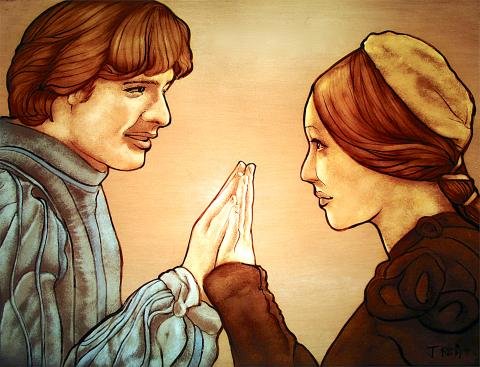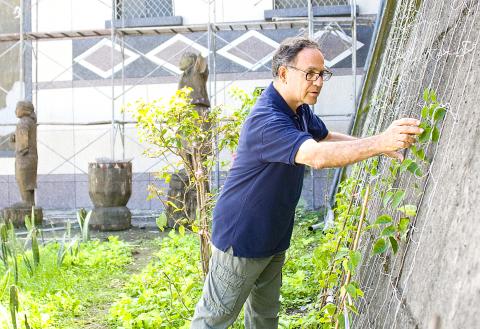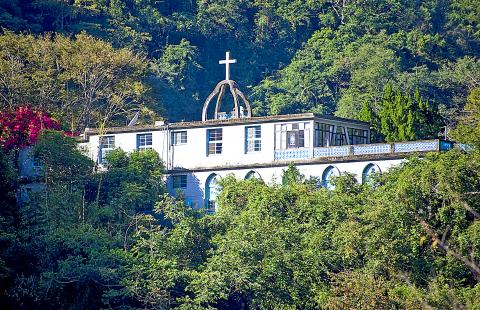Father Barry Martinson says there is an element of suffering to making art. He liked painting and writing when he was a child, but ever since he arrived in Chingchuan Village (清泉), an Aboriginal community nestled in the picturesque mountains of eastern Hsinchu, it has become more of a “mission” to beautify his surroundings, whether it be murals depicting Aboriginal life in his church or mosaics on the walls of a basketball court.
And now, he is on a mission to renovate the community’s main street.
“Some people just love to paint and paint. I don’t. I’ve got to have a motivation,” he says.

Photo courtesy of Barry Martinson
Martinson says in the 40 years he’s lived in Chingchuan, it has gone from attractive brick houses to drab concrete blocks and tin shacks. Neither he nor the villagers have the money to beautify the street, so Martinson is putting on an exhibition of his stained-glass paintings at Taipei 101 starting tomorrow.
Martinson says he has wanted to clean up the streets for a long time, especially since the village has become a tourist destination due to its hot springs and the former residences of writer San Mao (三毛) and former Chinese Nationalist Party (KMT) marshal Chang Hsueh-liang (張學良), who served part of his house arrest here for kidnapping KMT leader Chiang Kai-shek (蔣介石) in 1936.
“This is all people see of our village,” Martinson says. “As far as they’re concerned, Chingchuan is just a bunch of shacks. I think: ‘what a shame.’”

Photo: Han Cheung, Taipei Times
Neither the villagers, mostly laborers and farmers, nor Martinson had the funds to do anything, so he started making and selling stained-glass paintings. The remaining pieces — mostly consisting of movie scenes — will be displayed at Taipei 101 starting tomorrow, along with a choral performance by village children.
Martinson has three helpers for his work, which is done in the traditional way with multiple shadings and firings. The vivid, figurative pieces with detailed shading and thick black outlines can be lit up with a built-in LED light.
The original theme for this collection was “Faces of Love,” which not only includes Biblical images but also movie scenes and famous figures, including Audrey Hepburn and the Buddha.

Photo: Han Cheung, Taipei Times
“The idea was so the beautiful face of the village would come from the beautiful faces of the stained glass,” Martinson says.
YOU ARE YOUR HOUSE
Martinson is happy now when he leaves his church to visit with villagers, mostly Atayal Aborigines.
Three years ago, his paintings funded the youth community center, sprucing up an abandoned building in the process. For the past month, scaffolding has aligned the street as workers have installed geometric Atayal patterns to the facades of the concrete houses.
A large tribal mosaic is planned for the tallest, four-story building whose bleak gray side faces incoming traffic. An empty landing has been turned into a garden, with plants set to climb up an otherwise drab retaining wall.
“People were pleased that there was a tribal flavor without being too conspicuous,” Martinson says. “I wanted it to look like it’s been there all the time.”
Martinson says most of the project has been completed with local labor.
“The idea is to help people realize that this is a renovation not only of your exterior but your interior,” he says. “That their street is beautiful should help them feel pride about themselves. I always say, you are your house.”
Martinson’s plans for the village don’t end here. His next goal is to create a loop through the village for tourists to stroll around instead of going straight to the attractions. Then villagers can make some extra income by setting up stands outside their homes.
Jesuit priests can request to be transferred, and Martinson has thought of leaving many times, but each time, he’s decided against it.
“It’s my faith,” he says. “I don’t wear it on my sleeve, but we believe that when our superior sends us somewhere, it’s where God wants us to be. Then it’s the people ... and third, the nature.”
EXHIBITION NOTES
What: Love in the Movies Stained Glass Paintings
When: Tomorrow to Dec. 11
Where: Gallery 101 (in Taipei 101), 7, Sec 5, Xinyi Rd, Taipei City (台北市信義路5段7號)
Details: Auction on Dec. 11
On the Net: www.facebook.com/丁松青神父愛的容顏-1449027295406227/

In the March 9 edition of the Taipei Times a piece by Ninon Godefroy ran with the headine “The quiet, gentle rhythm of Taiwan.” It started with the line “Taiwan is a small, humble place. There is no Eiffel Tower, no pyramids — no singular attraction that draws the world’s attention.” I laughed out loud at that. This was out of no disrespect for the author or the piece, which made some interesting analogies and good points about how both Din Tai Fung’s and Taiwan Semiconductor Manufacturing Co’s (TSMC, 台積電) meticulous attention to detail and quality are not quite up to

April 21 to April 27 Hsieh Er’s (謝娥) political fortunes were rising fast after she got out of jail and joined the Chinese Nationalist Party (KMT) in December 1945. Not only did she hold key positions in various committees, she was elected the only woman on the Taipei City Council and headed to Nanjing in 1946 as the sole Taiwanese female representative to the National Constituent Assembly. With the support of first lady Soong May-ling (宋美齡), she started the Taipei Women’s Association and Taiwan Provincial Women’s Association, where she

Chinese Nationalist Party (KMT) Chairman Eric Chu (朱立倫) hatched a bold plan to charge forward and seize the initiative when he held a protest in front of the Taipei City Prosecutors’ Office. Though risky, because illegal, its success would help tackle at least six problems facing both himself and the KMT. What he did not see coming was Taipei Mayor Chiang Wan-an (將萬安) tripping him up out of the gate. In spite of Chu being the most consequential and successful KMT chairman since the early 2010s — arguably saving the party from financial ruin and restoring its electoral viability —

It is one of the more remarkable facts of Taiwan history that it was never occupied or claimed by any of the numerous kingdoms of southern China — Han or otherwise — that lay just across the water from it. None of their brilliant ministers ever discovered that Taiwan was a “core interest” of the state whose annexation was “inevitable.” As Paul Kua notes in an excellent monograph laying out how the Portuguese gave Taiwan the name “Formosa,” the first Europeans to express an interest in occupying Taiwan were the Spanish. Tonio Andrade in his seminal work, How Taiwan Became Chinese,